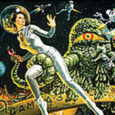 Metro-Goldwyn-Mayer/Toei / Warner Home Video (1968 / 2010), single disc,
Metro-Goldwyn-Mayer/Toei / Warner Home Video (1968 / 2010), single disc,
90 mins, 2.35:1 anamorphic widescreen, Dolby Digital, Rated G, $25
The Movie:
Cheap, tacky, ludicrously plotted, badly performed and sometimes bafflingly directed, The Green Slime is everything you look for in a movie that, with a title like that, can only be so bad it’s great! Seriously, there’s a surprising amount of genuinely good stuff in here that lifts the film from the usual sci-fi schlock of the period and makes it pure, unadulterated, F.U.N. – so long as you can put up with my terrible acronym for Fantastic, Unintentionally-hilarious Nonsense!
With the success of the Americanization of Godzilla in the 1950s, Japan fairly quickly became the home of the Creature Feature: low-budget movies about giant freaks of nature running rampage through big cities, or unthawed dinosaurs running rampage through big cities, or robot monsters on the loose…running rampage through big cities! Although Japan’s Toei Film Company was one of, if not the, leader in home grown production, most of these movies would be re-framed for the international market to feature some kind of on the way up or on the way down marquee name from the States, additional scenes inserted to make it seem they were in the production from the beginning.
Although these films were pretty terrible (some even in a good way!), they were cheap to make and almost always turned a profit. Filmmakers from other countries – most notably Italy – were quick to jump in on the act, and the American studios did not let these successes pass them by completely. Shipping out entire stock players but using local crew in order to make “authentic” American films cost effectively in these countries, became something of its own sub-industry, leading to such brilliantly bonkers Japanese classics as King Kong Escapes and King Kong Vs Godzilla, in which the two legendary movie monsters run rampage through the big city!
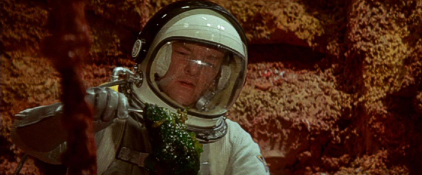 Italy, where don’t forget, before they achieved critical acclaim, Eastwood and Leone’s Dollars Trilogy were originally envisioned as el cheapo westerns (hence the spaghetti western tag), bounced back with a whole slew of space set melodramas in the wake of the success of such shows on television.
Italy, where don’t forget, before they achieved critical acclaim, Eastwood and Leone’s Dollars Trilogy were originally envisioned as el cheapo westerns (hence the spaghetti western tag), bounced back with a whole slew of space set melodramas in the wake of the success of such shows on television.
The first in the so-called Gamma 1 Quadrilogy was 1965’s Wild Wild Planet, originally intended for television but given a big screen release by MGM. Four films had been contracted to shoot simultaneously, to save on special effects, and this was quickly followed up by Diaphanoids, Bringers Of Death (aka War Of The Planets) in 1966, War Between The Planets (you can see how this can get confusing) just a couple of months later, and The Snow Devils (aka Devil Men From Space) in 1967.
From those kinds of titles, you should know by now if reading anything further about The Green Slime will either have you navigating away from this review, or fervently reading on with excitement! Producers Ivan Reiner and Walter Manley certainly were: the pair had made the Gamma 1 films and were eager to make more of the same. MGM decided on a Gamma III series, set on a new space station, but pushed for a Japanese direction instead. Reiner and Manley decided on director Kinji Fukasaku to helm the new adventure, and though it very much follows in the footsteps of the previous Gamma movies, MGM’s financial struggles of the time meant it would be the only one produced, coming out in 1968, the same year as MGM’s more creditable space drama 2001: A Space Odyssey…talk about a questionable double bill!
Actually, although I was expecting a so bad it’s good movie, I wasn’t expecting The Green Slime to also include some pretty good ideas of its own. Yes, it does through in the typical love-triangle/feisty relationship between the station’s commander (Richard Jaeckel), the hot-shot problem solver come to save the day (Robert Horton) and the girl they’re both in love with (Italian Thunderball actress Luciana Paluzzi, and it does have the pre-requisite wooden plank performances and monkey scriptwriting, but it’s actually pretty well made…for a slice of cheap sci-fi junk!
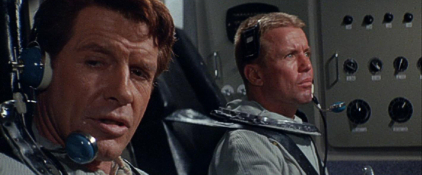 The opening premise, that Earth is about to be blown to bits by a huge asteroid, has Horton boarding Gamma III, where he’ll take command of a mission to land two rockets on the chunk of space rock and blow it to bits. Put your imagination into overdrive, and it’s Armageddon thirty years before Bruce Willis went up to pull off the same trick, though granted the “spectacular effects” are cheesy as heck.
The opening premise, that Earth is about to be blown to bits by a huge asteroid, has Horton boarding Gamma III, where he’ll take command of a mission to land two rockets on the chunk of space rock and blow it to bits. Put your imagination into overdrive, and it’s Armageddon thirty years before Bruce Willis went up to pull off the same trick, though granted the “spectacular effects” are cheesy as heck.
It’s on the rock that a scientist along for the ride accidentally contracts some “green slime” on his space suit, unintentionally taking it back with him (after the required slapping down from the commander for being so careless, natch) to Gamma III, where it quickly begins to spread uncontrollably. Any attempts to blast it create more slime creatures from its green blood, all of them energy guzzlers that grow in size with every zap! At this point, the film begins to resemble Alien, ten years before that milestone, though the basic “monster loose in an enclosed location in space” plot is hard to shake off.
Of course, The Green Slime is nowhere as mean or scary as Alien, as the film’s original G-rating will attest, the film is more geared towards families that watched Star Trek or Lost In Space at the time, though now it simply entertains with its ludicrous melodramatic turns and, at one point, an attempt to whip up some action frenzy with the camera zooming in and out wildly, desperately searching for the actors’ faces to focus on again and not doing anything really remotely dramatic other than absolutely creasing up today’s audiences. An early indication of where the film is going (even after the hilarious “asteroid”, which basically resembles a meatball…ahh the Italian connection again!) is when the opening song (yes, there’s a theme song!) starts to blare out: “Greeeeeen Sliiiiiime! Greeeeeen Sliiiiiiime!” – brilliant, just brilliant.
 That song (covered, apparently, Josie Cotton on a 2007 album Invasion Of The B-Girls) and the film’s score was written by Charles Fox, composer of over one hundred films and the writer behind many of the 1970s and 80s’ best television themes: look him up, since the list is way too populated to start highlighting here.
That song (covered, apparently, Josie Cotton on a 2007 album Invasion Of The B-Girls) and the film’s score was written by Charles Fox, composer of over one hundred films and the writer behind many of the 1970s and 80s’ best television themes: look him up, since the list is way too populated to start highlighting here.
Leading man Horton was in these kinds of things for a reason; solid but emotionless, he made a career from being a featured player on a multitude of television shows over the years (recurring in such anthologies as Studio 57, Matinee Theater, Alfred Hitchcock Presents and the western series Wagon Train), while Jaeckel is a supporting actor face that I absolutely guarantee you’ll recognize from any of his endless list of TV and film appearances (among them the original 3:10 To Yuma, The Dirty Dozen and, bizarrely but perhaps most appropriately for readers of this site, as John Vernon’s accomplice in Herbie Goes Bananas)!
They’re joined by an impressive number of background players, many of them American military, amateur actors and female models based in Japan, and all of them displaying their uniquely terrible acting abilities to enormously amusing effect. And once the Green Slime itself has attached itself to the Gamma III space station and proven to be indestructible, the real fun begins, as the monsters become gaping one-eyed walking killers (or Japanese children in rubber suits, as they were)! Actually, that sounds totally ridiculous – and it is – but The Green Slime would just be a bad movie if it was only as good as that.
 So, somewhat impressively given the budget and no-doubt strange working conditions in speaking to each other through a translator, director Fukasaku manages to hold together the pacing of the movie so that it never really lets up, as well as being able to rely on the actually quite good special effects, rubber suits aside, and the CinemaScope ratio framing that adds a heap of value to any of his shots.
So, somewhat impressively given the budget and no-doubt strange working conditions in speaking to each other through a translator, director Fukasaku manages to hold together the pacing of the movie so that it never really lets up, as well as being able to rely on the actually quite good special effects, rubber suits aside, and the CinemaScope ratio framing that adds a heap of value to any of his shots.
What I was often reminded of, in the miniature set construction, was the detail of Gerry Anderson’s Thunderbirds and Captain Scarlett Super-Marionation programs, with giant rockets and wide shots of “sets” being well matched to the scale-sized sections the actors would then appear next to. There’s also a couple of instances of reverse footage depicting the slime “climbing” up walls and such, which is simple but effective!
On the flipside of this, though, the Gamma III station never really feels adequately big enough in size, and borders hilariously on the Ed Wood scale when fire engulfs it towards the end, though to nitpick on something like that in a film like this is to miss the point. The Green Slime was produced with a quickie B-Movie mentality in mind but, although it delivers on all points in those regards, it’s also good in it’s own way. Despite the space station’s doors not always swooshing closed as smoothly as they might, and despite the many clunking dramatic turns to camera to speak outrageously preposterous lines of dialogue, it’s a fantastically nuts, hugely enjoyable space ride in the low-grade tradition of the best worst movies!
The Disc:
Making its DVD debut as part of the Studio’s manufactured on demand discs, The Green Slime is the first of the Warner Archive discs that I’ve come across that has boasted the Remastered Edition banner along the top of the sleeve, leading me to assume that this would essentially be as good a release as a widely commercially available pressing in all but the proprietary DVD-R format. I’ve questioned for a while now if the Archive Collection has become something of a dumping ground for some titles to find an outlet even when a wider release would have originally been on the cards, and the popularity of The Green Slime suggests WB would have done well to put it out as such.
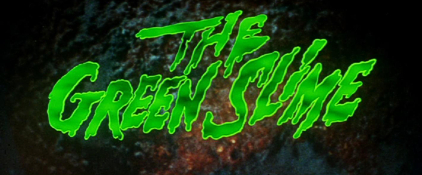 Instead, they’ve gone the Archive route – seemingly more and more a place for borderline titles to be found – though the Remastered tag doesn’t, ultimately, count for much going by the results here.
Instead, they’ve gone the Archive route – seemingly more and more a place for borderline titles to be found – though the Remastered tag doesn’t, ultimately, count for much going by the results here.
Transfers for the Archive Collection can be a random game of good or bad, and while there’s nothing really “wrong” with the correctly framed anamorphic widescreen print here, it’s not as spotless as a Remastered label might have you believe. I’ve seen plenty of WB Archive titles with transfers as good as this, and was initially disappointed with the amount of print debris to be found at the beginning of the film.
It soon clears up about five minutes in, but don’t be expecting to compare this to a commercial release: it’s a good, solid Archive release, but nothing phenomenally special. In a way, a few scratches here and there add to the B-Movie fun, and WB can only do what they can with what they have, but to slap the Remastered tag on the cover and charge $5 more for the privilege suggests a higher level of quality than we get here, good enough as it is. The mono soundtrack – probably as was original created – makes up for it, sounding as good as it needs to for such a film, without any distractions or signal noise to ruin things, and the slime creatures’ high-pitched whining itself is as bonkers an effect as they look.
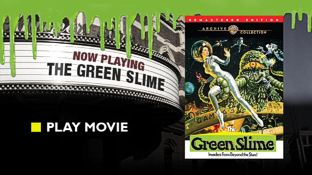 In terms of extras, The Green Slime disappoints the most: even the most mundane and routine Archive releases have managed to muster up a theatrical trailer, and you’d think a Remastered Edition would once again provide something like that and more.
In terms of extras, The Green Slime disappoints the most: even the most mundane and routine Archive releases have managed to muster up a theatrical trailer, and you’d think a Remastered Edition would once again provide something like that and more.
The film was the focus of Mystery Science Theater 3000’s never aired pilot episode, which would have been pretty cool to see, as would the 77-minute Japanese cut of the film, prepared by director Fukasaku to remove the love-triangle plot and run as a potentially more action adventure film, with alternate music cues, additional ending scenes, and re-named Gamma III: Big Military Space Operation (or Operation Outer Space) to play in a children’s double feature matinee with the animated feature Pinocchio In Outer Space.
Disappointingly, there isn’t even a theatrical trailer – easily available if the YouTube appearance is anything to go by – and the smart move would have been to include not only The Green Slime but trailers for the other Gamma movies, also available from the Warner Archives, or even package the series as a boxed set!? At least the theatrical poster art has been used on the front of the sleeve – typical in that it depicts a sexy-looking Paluzzi being tackled by one of the slime monsters in outer space, but a bit of a stretch considering the scenes that are actually in the movie! The black and white back cover photos don’t really sell the widescreen full-color cinematography of the movie, but chances are you’re looking at The Green Slime if you’re a bad sci-fi nut anyway, and pretty much know what to expect.
Cinematic Classic or Faded Print?
The complete lack of any extras other than a “Play Movie” menu screen coupled with a transfer that, while pleasingly sharp and in its correct anamorphic ratio, is otherwise not as speckle-free as the Remastered Edition label (and higher price tag) suggests, means a purchase of The Green Slime will be down to how much you may crave the title on DVD. And though it’s huge fun, the inflated $25 cost is more than even other Remastered titles, for some reason, which makes it hard to recommend a vanilla disc that only contains a “joke” movie, however funny that movie may be. A wait for a lower cost digital download, price drop, or deal on an Archive bundle may be the way to go, though for fans of this kind of film, you just have to see it to believe it!
and many others directly from the online store at WB ARCHIVE COLLECTION



